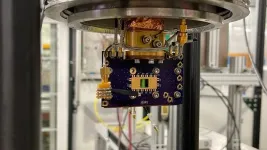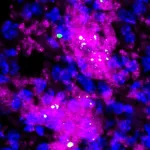(Press-News.org) Particle detectors play a crucial role in our understanding of the fundamental building blocks of the universe. They allow scientists to study the behavior and properties of the particles produced in high-energy collisions. Such particles are boosted to near the speed of light in large accelerators and then smashed into targets or other particles where they are then analyzed with detectors. Traditional detectors, however, lack the needed sensitivity and precision for certain types of research.
Researchers at the U.S. Department of Energy’s (DOE) Argonne National Laboratory have made a significant breakthrough in the field of high-energy particle detection in recent experiments conducted at the Test Beam Facility at DOE’s Fermi National Accelerator Laboratory (Fermilab).
“This was a first-of-its-kind use of the technology. This step was critical to demonstrate that the technology works the way we want it to because it is typically geared toward photons. It was a key demonstration for future high-impact applications.” — Whitney Armstrong, Argonne physicist
They have found a new use for the superconducting nanowire photon detectors (SNSPDs) already employed for detecting photons, the fundamental particles of light. These incredibly sensitive and precise detectors work by absorbing individual photons. The absorption generates small electrical changes in the superconducting nanowires at very low temperatures, allowing for the detection and measurement of photons. Specialized devices able to detect individual photons are crucial for quantum cryptography (the science of keeping information secret and secure), advanced optical sensing (precision measurement using light) and quantum computing.
In this study, the research team discovered that these photon sensors could potentially also function as highly accurate particle detectors, specifically for high-energy protons used as projectiles in particle accelerators. Found in the atomic nucleus of every element, the proton is a particle with a positive electrical charge.
The team’s breakthrough opens up exciting opportunities in the field of nuclear and particle physics.
“This was a first-of-its-kind use of the technology,” said Argonne physicist Whitney Armstrong. “This step was critical to demonstrate that the technology works the way we want it to because it is typically geared toward photons. It was a key demonstration for future high-impact applications.”
The team made SNSPDs with different wire sizes and tested them with a beam of 120 GeV protons at Fermilab, which was the nearest facility equipped to carry out this experiment. These high-energy protons are important because they allow researchers to simulate and study the conditions under which SNSPDs might operate in high-energy physics experiments, providing valuable insights into their capabilities and limitations.
They found that wire widths smaller than 400 nanometers — the width of a human hair is approximately 100,000 nanometers — demonstrated the high detection efficiency needed for high-energy proton sensing. Further, the study also revealed an optimal wire size of approximately 250 nanometers for this application.
In addition to their sensitivity and precision, SNSPDs also operate well under high magnetic fields, making them suitable for use in the superconducting magnets used in accelerators to boost particle velocity. The ability to detect high-energy protons with SNSPDs has never been reported before, and this breakthrough widens the scope of particle detection applications.
“This was a successful technology transfer between quantum sciences, for photon detection, into experimental nuclear physics,” said Argonne physicist Tomas Polakovic. “We took the photon-sensing device and made slight changes to make it work better in magnetic fields and for particles. And behold, we saw the particles exactly as we expected.”
This work also demonstrates the feasibility of the technology for use in the Electron-Ion Collider (EIC), a cutting-edge particle accelerator facility being built at DOE’s Brookhaven National Laboratory. The EIC will collide electrons with protons and atomic nuclei (ions) to get a better look at the internal structure of those particles, including the quarks and gluons that make up the protons and neutrons of nuclei.
The EIC requires sensitive and precise detectors, and SNSPDs will be valuable tools for capturing and analyzing the resulting particles produced in collisions within the EIC. “The proton energy range that we tested at Fermilab is right in the middle of the span of the ion’s energy range that we will detect at EIC, so these tests were well-suited,” said Sangbaek Lee, a physics postdoctoral appointee at Argonne.
The research team made use of the Reactive Ion Etching tool at the Center for Nanoscale Materials, a DOE Office of Science user facility at Argonne.
Other contributors to this work include Alan Dibos, Timothy Draher, Nathaniel Pastika, Zein-Eddine Meziani and Valentine Novosad.
The results of this research were published in Nuclear Instruments and Methods in Physics Research Section A. The study was funded by the DOE Office of Science, Office of Nuclear Physics.
About Argonne’s Center for Nanoscale Materials
The Center for Nanoscale Materials is one of the five DOE Nanoscale Science Research Centers, premier national user facilities for interdisciplinary research at the nanoscale supported by the DOE Office of Science. Together the NSRCs comprise a suite of complementary facilities that provide researchers with state-of-the-art capabilities to fabricate, process, characterize and model nanoscale materials, and constitute the largest infrastructure investment of the National Nanotechnology Initiative. The NSRCs are located at DOE’s Argonne, Brookhaven, Lawrence Berkeley, Oak Ridge, Sandia and Los Alamos National Laboratories. For more information about the DOE NSRCs, please visit https://science.osti.gov/User-Facilities/User-Facilities-at-a-Glance.
Argonne National Laboratory seeks solutions to pressing national problems in science and technology by conducting leading-edge basic and applied research in virtually every scientific discipline. Argonne is managed by UChicago Argonne, LLC for the U.S. Department of Energy’s Office of Science.
The U.S. Department of Energy’s Office of Science is the single largest supporter of basic research in the physical sciences in the United States and is working to address some of the most pressing challenges of our time. For more information, visit https://energy.gov/science.
END
From photons to protons: Argonne team makes breakthrough in high-energy particle detection
Beam tests demonstrate high-energy particle detection with superconducting nanowires
2025-02-11
ELSE PRESS RELEASES FROM THIS DATE:
Cancer’s ripple effect may promote blood clot formation in the lungs
2025-02-11
Blood clots form in response to signals from the lungs of cancer patients—not from other organ sites, as previously thought—according to a preclinical study by Weill Cornell Medicine, Memorial Sloan Kettering Cancer Center and University of California San Diego Health. Clots are the second-leading cause of death among cancer patients with advanced disease or aggressive tumors.
While blood clots usually form to stop a wound from bleeding, cancer patients can form clots without injury, plugging up vessels and cutting off circulation to organs. The study, published Feb. 11 in Cell, shows that tumors drive clot formation (thrombosis) by releasing ...
New UVA clinical trial explores AI-powered insulin delivery for better diabetes care
2025-02-11
For people living with Type 1 Diabetes (T1D), keeping blood sugar levels in check is a constant challenge. A new clinical trial at UVA is aiming to simplify diabetes management by testing an innovative AI-powered device designed to improve automated insulin delivery.
The trial is co-led by several School of Data Science faculty, including Assistant Professor of Data Science Heman Shakeri; Boris Kovatchev, founding director of the UVA Center for Diabetes Technology, a professor at the School of Medicine and professor ...
New technology could quash QR code phishing attacks
2025-02-11
The ubiquitous QR (“quick response”) codes that appear on everything from parking pay stations to soda cans and promotional flyers have become an increasingly popular target for cybercriminals to exploit through QR code–based phishing attacks, also known as “quishing.” Bad actors will place phony QR codes that direct smartphone users to enter their sensitive private information in fake websites masquerading as bank websites, parking enforcement offices, or other seemingly ...
Study reveals direct gut-brain communication via vagus nerve
2025-02-11
A new study in an animal model provides direct evidence for the role of the vagus nerve in gut microbiome-brain communication, addressing a critical gap in the field.
The research, led by Kelly G. Jameson while a PhD student in the Hsiao Lab at UCLA, demonstrates a clear causal relationship between gut microbiota and vagal nerve activity.
While the vagus nerve has long been thought to facilitate communication between the gut microbiome—the community of microorganisms living in the intestines—and the brain, direct evidence for this process ...
MSU expert: Using light to hear biology
2025-02-11
Images
Elad Harel is used to shining a light on the mysteries of the natural world.
Working at the cutting-edge of ultrafast spectroscopy — the application of short laser pulses to analyze the dynamics of molecules — the Michigan State University associate professor’s research aims to reveal how microscopic phenomena impact large complex systems.
One promising frontier Harel has been working on is the development of new methods of microscopy that will allow researchers to observe molecular and atomic landscapes in motion rather than through static imagery. Such work has earned Harel MSU’s 2023 ...
“I can’t hear you, I’m too stressed”: Repeated stress in mice reduces sound perception
2025-02-11
After a week of stress, mice show changes in how their brains process sound, reducing how well they perceive loud noises, according to a study published February 11th in the open-access journal PLOS Biology led by Ghattas Bisharat, from the Ben-Gurion University of the Negev in Israel, and colleagues.
Repeated stress has negative impacts on mental health that can go beyond psychiatric disorders. They can also cause changes in how we perceive the world, making us jump at loud noises, or become easily irritated by scratchy sweaters or offensive odors. To understand how repeated stress can impact how the brain processes sensory information, the authors ...
Chronic stress affects how brain processes sound in mice
2025-02-11
BEER-SHEVA, Israel, February 11, 2025 – Chronic stress changes the way our brain processes sounds, according to new research conducted on mice at Ben-Gurion University of the Negev. For instance, sounds need to be louder during chronic stress to trigger similar responses.
Chronic stress is known to impact learning and decision-making, but could it also affect how we hear? Dr. Jennifer Resnik from Ben-Gurion University’s Department of Life Sciences set out to find whether stress influences basic brain functions, ...
Insilico Medicine announces developmental candidate benchmarks and timelines for novel therapeutics discovered using generative AI
2025-02-11
Cambridge, MA – Insilico Medicine ( “Insilico”) , a clinical stage generative artificial intelligence (AI)-driven biotechnology company today announced a set of preclinical drug discovery benchmarks from the 22 developmental candidate nominations achieved by its platform from 2021 to 2024. These benchmarks underscore the platform's efficiency and represent a potential new standard for the drug discovery industry by significantly reducing developmental times, cost, and by allowing resources to be redirected toward further ...
A wealth of evidence: PIK compiles 85,000 individual studies about climate policy
2025-02-11
“Rather than directly providing answers to questions about the effects of climate policies, this study displays an overview of what has actually been scientifically studied so far,” explains Max Callaghan, PIK researcher and lead author of the study. “On the one hand, this informs existing gaps and thus directions for primary research, including through funding. On the other hand, this overview facilitates evidence synthesis work, i.e. the summarisation of the state of knowledge for governments, for example in the IPCC Assessment Reports.”
The study shows, among other ...
New fish species with ‘face paint’ named after Studio Ghibli character
2025-02-11
Researchers in China have named a newly discovered fish species after the Studio Ghibli character San from Princess Mononoke based on its similar facial markings.
Published in the open-access journal ZooKeys, Branchiostegus sanae is a deepwater tilefish belonging to the family Branchiostegidae. It was discovered when scientists noticed unique cheek pattern on some deepwater tilefish individuals in online seafood markets.
The research team used genetic analysis to confirm the new-species status of the fish, and were inspired by its facial stripes to name it after the female protagonist, San, from Hayao Miyazaki’s animated film Princess Mononoke, choosing “sanae” ...
LAST 30 PRESS RELEASES:
$80 million in donations propels UCI MIND toward world-class center focused on dementia
Illinois research uncovers harvest and nutrient strategies to boost bioenergy profits
How did Bronze Age plague spread? A sheep might solve the mystery
Mental health professionals urged to do their own evaluations of AI-based tools
Insufficient sleep associated with decreased life expectancy
Intellicule receives NIH grant to develop biomolecular modeling software
Mount Sinai study finds childhood leukemia aggressiveness depends on timing of genetic mutation
RSS Research Award for new lidar technology for cloud research
Novel AI technique able to distinguish between progressive brain tumours and radiation necrosis, York University study finds
Why are abstinent smokers more sensitive to pain?
Alexander Khalessi, MD, MBA, appointed Chief Innovation Officer
Optical chip pioneers physical-layer public-key encryption with partial coherence
How your brain understands language may be more like AI than we ever imagined
Missed signals: Virginia’s septic strategies overlook critical timing, study warns
Delayed toxicities after CAR T cell therapy for multiple myeloma are connected and potentially preventable
Scientists find cellular key to helping plants survive in saltwater
Medical cannabis program reduces opioid use
Immunotherapy works for sepsis thanks to smart patient selection
Cardiovascular events 1 year after RSV infection in adults
US medical prices and health insurance premiums, 1999-2024
Medical cannabis and opioid receipt among adults with chronic pain
Multichannel 3D-printed bioactive scaffold combined with siRNA delivery for spinal cord injury recovery
Triaptosis—an emerging paradigm in cancer therapeutics
A new paradigm in spectroscopic sensing: The revolutionary leap of SERS-optical waveguide integration and ai-enabled ultra-sensitive detection
Sweet tooth: How blood sugar migration in diabetes affects cavity development
Lowest suicide rate is in December but some in media still promote holiday-suicide myth
Record-breaking cosmic explosion challenges astronomers’ understanding of gamma-ray bursts
Excessive heat harms young children’s development, study suggests
Quanta Books to publish popular math and physics titles by Terence Tao and David Tong
Philanthropic partnerships fund next-generation instruments for mid-sized telescopes
[Press-News.org] From photons to protons: Argonne team makes breakthrough in high-energy particle detectionBeam tests demonstrate high-energy particle detection with superconducting nanowires






